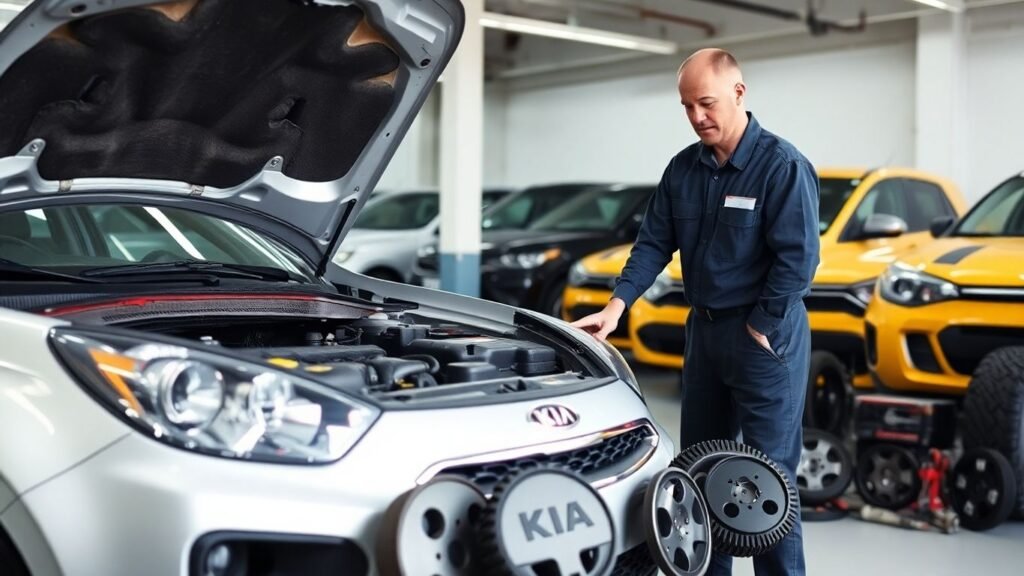If you’ve ever wondered how Kia wreckers keep old models running like new, you’re not alone. Many drivers want their Kias to last as long as possible without breaking the bank. The truth is, with the right parts, good maintenance, and a bit of know-how, your Kia can keep going strong for years. Kia wreckers are experts at finding genuine parts, solving tricky problems, and giving honest advice. They help drivers get the most out of their cars, even after the warranty is long gone. Let’s dig into how they do it—and what you can do to keep your own Kia in top shape.
Key Takeaways
- Using genuine Kia parts is one of the best ways to keep your car reliable and safe.
- Certified Kia technicians have the right training and tools to spot and fix problems quickly.
- Routine oil changes, brake checks, and tire inspections go a long way toward making your Kia last.
- Seasonal tire swaps and keeping an eye on tire pressure keep you safer all year round.
- Sticking to the service schedule and catching issues early saves money and prevents bigger headaches later.
How Kia Wreckers Keep Old Models Running Like New With Genuine Parts

Kia wreckers don’t just tear old cars apart for scraps—they actually give aging Kias a second shot at life. You’ll find that using genuine Kia parts is the single most important thing you can do to keep your car running well long after the factory warranty is over. These parts are made just for your specific Kia, so each one fits the way it should and works right with the car’s systems. Let’s go a bit deeper into why this matters, and what makes the real thing stand apart from generic alternatives.
Advantages of Kia Genuine Parts Over Aftermarket Options
When you need a replacement part, it might be tempting to grab an aftermarket piece from your local big-box parts store. Here’s the thing about that—aftermarket parts are designed to fit a whole range of cars, not just yours. They might go on fine, but subtle differences can mean they wear out sooner or accidentally mess with how other systems work. Genuine Kia parts were engineered for your exact model. This can lead to a longer-lasting fix and fewer surprises down the road. If you drive a high-mileage Kia, that reliability is everything. Counterfeit or salvage yard deliveries just don’t match up when you want peace of mind.
| Feature | Genuine Kia Part | Aftermarket Part |
|---|---|---|
| Fits Your Kia Exactly | Yes | Sometimes |
| Warranty Coverage | Yes | Maybe/No |
| Rigorous Testing | Yes | Rarely |
| Manufacturer Backed | Yes | No |
Rigorous Testing for Durability and Safety
People don’t always think about how hard automakers push their own parts before selling them. Kia-branded components go through long rounds of stress tests and heat cycles, often in conditions much worse than you’ll ever see on the road. This sort of testing weeds out anything that won’t last, so only the sturdiest parts make it to your car. On the other side, non-genuine parts can skip steps or use different materials to save money, which sometimes means they don’t hold up—especially in older models that need all the help they can get.
Even in tough city driving or after a harsh winter, genuine parts keep things running the way engineers planned, so that old Kia stays dependable regardless of what the road throws at it.
Warranty Support You Can Trust
If you’re spending money on car repairs, you want to be protected if something goes wrong. Genuine Kia parts come with a warranty, usually covering you for at least 12 months (sometimes much longer, depending on the part). That means if your new air filter, brake pad, or battery acts up, Kia stands by it. Go the aftermarket route, and you’re either out of luck or facing a confusing warranty process at best. Backing up repairs with real support—especially for older cars—is a huge deal, since even one faulty component can set you back.
Older Kias don’t have to be unreliable. With the right genuine parts, you get fits-like-new performance, rock-solid safety, and backup from the people who built your car in the first place.
Expert Diagnostics and Specialized Repairs For All Kia Models
Kia models have their quirks, and not every mechanic knows how to spot the hidden issues or fine-tune their performance. At Kia wreckers, the technicians spend years working on nothing but Kia vehicles. They know the sounds, the warning lights, and the patterns that point to specific model problems—so you skip the guessing games and get straight answers. These folks have seen it all, from a squeaky Forte to a Sportage with a stubborn transmission. Their hands-on experience means faster, more accurate repairs.
Modern Tools for Accurate Problem-Solving
Kia’s onboard computers and electronic systems get smarter every year. That means you can’t just use an old-school diagnostic scanner or hope for the best. Shops that really specialize in Kia use dealer-grade digital tools and software that "speak Kia’s language." This lets them find broken sensors, odd electronic glitches, or early signs of trouble before small things turn into big repairs. Sometimes it’s as simple as updating vehicle software; sometimes, it’s tracking down a wire that nobody else would check.
| Diagnostic Tool | What It Detects | Repair Turnaround |
|---|---|---|
| Kia GDS Analyzer | Engine codes, sensor faults | Same day |
| Digital Brake Scanner | ABS/Wheel speed issues | 1-2 days |
| Factory HVAC Scanner | Climate/Electrical flaws | 1 day |
Your car shouldn’t leave the shop until every quirk and error code gets a full explanation, so you leave knowing exactly what was fixed—and why.
Tailored Maintenance for Popular Kia Models
There’s no generic one-size-fits-all approach here. Each Kia needs something a little different based on the year, the engine, and how it’s been driven. For instance, a Sorento that’s spent years hauling a family and gear probably needs earlier transmission fluid changes. A Soul with lots of city miles could show early signs of wear in its HVAC controls or battery system. Specialists make maintenance plans that match the car’s story. Older models get the care their age demands, and newer ones get tweaks that keep their high-tech features working reliably.
There’s a real comfort in knowing your car is with folks who focus on Kia day in and day out. They aren’t just following a checklist—they’re keeping track of the little stuff other shops might miss.
Routine Maintenance: The Key to Expanding Your Kia’s Lifespan
Taking care of your Kia isn’t just about making it through another year—it’s about getting the most out of every mile. Routine maintenance is the difference between a car that’s always ready for the next road trip and one that lets you down when you need it most. It’s not all complicated stuff, either. A few key habits can add years to your engine and more cash in your pocket when it’s time to sell.
Essential Oil and Filter Changes for Longevity
Oil changes are like a breath of fresh air for your Kia’s engine. When you replace old oil and filters on time, you help your car avoid the sludge and heat that wear down moving parts. Driving on old oil just makes everything work harder—engines get hotter, parts wear out faster, and that’s when big, expensive repairs pop up. Most Kia owners should look at changing oil every 5,000 to 7,000 miles, though it depends on how and where you drive. If you’re stuck in stop-and-go traffic or dealing with dusty backroads, more frequent changes are a smart move.
| Service | Recommended Interval | Typical Cost ($USD) |
|---|---|---|
| Oil & Filter Change | Every 5,000 – 7,500 mi | 50 – 100 |
Staying on top of oil changes keeps your engine healthy and can save you a ton of stress (and cash) later on.
Scheduled Brake and Tire Inspections
Your brakes and tires do more heavy lifting than you might think. Worn pads or uneven tire tread sneak up on you, especially if you only drive a little each week. By letting a service tech take a quick look every few months, you head off problems like squeaky, grinding brakes or bald tires that make wet roads risky. A good inspection checks everything—pad thickness, fluid levels, tire pressure, and tread depth—so you never have to guess if you’re safe on the road. Getting this done at least twice a year is smart, but more often is better if you drive long distances or carry heavy loads.
Sticking to the Recommended Service Intervals
So many people think, “I’ll get to it next month." Thing is, skipping regular service can turn a simple fix into a headache. The intervals set out in your Kia’s manual aren’t there for show—they’re based on what really works to keep your car running. Service at the right times helps you spot worn parts before they fail and means you’re less likely to get stuck waiting for a tow. It’s easy to forget, but some shops will send you reminders so you’re right on schedule.
Small habits, like regular oil changes and sticking to service intervals, add up and make your Kia last well past 100,000 miles—sometimes, even twice that.
Seasonal Tire Care and Safe Driving All Year Round
Making sure your Kia is ready for whatever the road throws at you means paying attention to the tires. Seasonal tire care isn’t just about keeping you moving—it’s about giving you peace of mind no matter the weather. Switching out tires when the seasons change improves grip, braking, and even the feel of your ride.
Benefits of Timely Tire Swaps and Alignment
Swapping your tires at the proper time has real-world benefits. Winter tires are softer and designed for snow and ice, while summer or all-season options handle hot pavement and rain. Missing that window means your car can’t perform at its best, and you could end up with strange noises, poor handling, or uneven wear. Wheel alignment matters, too—it’s not just about straight driving, but also about keeping your tires from wearing out too soon. Even a small misalignment makes the steering wheel feel off and the whole car just less trustworthy.
| Tire Type | Best For | Recommended Season |
|---|---|---|
| Winter Tires | Ice, snow, cold | Late fall to early spring |
| All-Season | Wet, mild, dry | Spring to mid-fall |
| Summer Tires | Hot, dry, rain | Late spring to early fall |
Choosing the Right Tires for Your Kia
It’s easy to just pick what’s cheapest or looks cool, but what really matters is matching the tire to your car’s size and the kind of roads you drive. Living outside the city? Think tougher treads. Slog through snow? Get real winter rubber. Checking your Kia’s manual won’t hurt, either. Dealers and Kia-focused shops can check your current tires and help you pick replacements that keep you safe and feeling good behind the wheel.
Taking care of your tires each season, instead of waiting for something to go wrong, means far fewer surprises or stressful roadside moments.
Tire Pressure and Tread Maintenance Tips
Even brand-new tires need some love. Checking pressure every month—yep, every month—helps your Kia stay planted on the road, especially when it gets hot or freezing overnight. Underinflated tires make for clunky driving and wear out way too fast. Overinflation isn’t great, either—it means less rubber touching the road, so grip disappears when you need it. Tread depth is the other thing nobody talks about until it’s too late. If your tires start looking bald or you see cracks, it’s time for inspection. Rotating your tires isn’t just something mechanics say to sound smart; it’s actually helpful. It keeps wear even and stretches your dollar a bit further.
A little attention during every season means your Kia grips, corners, and stops like it should—no matter how wild the weather gets.
Proactive Preventive Care That Pays Off
Taking a proactive approach does more than save money—it keeps your Kia feeling reliable and smooth long after most people give up on their rides. Getting ahead of little problems before they snowball is the real secret to long-lasting cars. Here’s how focusing on regular checks and in-the-moment fixes can keep your Kia running strong for years.
Monthly Fluid and Battery Checks
It’s easy to push routine checks to the bottom of the to-do list, but the truth is, checking fluids like coolant, oil, and brake fluid every month can save you from unexpected breakdowns. A quick look at your battery—making sure there’s no corrosion and that terminals are still clean—goes a long way, especially once the weather starts getting colder. If you keep an eye on these basics, you’ll dodge most of the stressful issues people complain about.
| Monthly Check | What to Look For | Why It Matters |
|---|---|---|
| Oil Level | Full, no burnt smell | Engine life, lubrication |
| Coolant | Clear, proper level | Prevents overheating |
| Brake Fluid | Amber color, topped up | Reliable stopping |
| Battery Terminals | No corrosion, tight cables | Easy starts, no stalls |
Staying on top of these small tasks means you’re much less likely to get stranded or surprised by a sudden warning light.
Spotting Early Signs of Wear and Malfunction
We all get used to how our cars sound and feel, so something as minor as a faint squeak when you brake or the AC blowing less cold air should make you pause. The first signs of trouble often fly under the radar—a grinding noise, sluggish acceleration, odd smells, dimming headlights. The minute you notice something off, it’s time to take action. Even something as simple as uneven tire wear or a weird pull when you’re steering can hint at bigger issues below the surface. The upside? Early fixes usually cost less and keep your Kia out of the shop for longer stretches.
DIY Upkeep and When to Seek Professional Help
There’s plenty you can do yourself—topping off fluids, swapping wiper blades, even inspecting tire pressure if you have a simple gauge. But there’s a point where DIY just isn’t enough. If you spot persistent warning lights, dead batteries that jump right back to being stubborn, or leaks that keep coming back, it’s better to let trained eyes handle it. Pro mechanics have the diagnostic tools and know-how to solve the hard stuff and prevent further damage, so you won’t be gambling with your car’s future.
Doing what you can at home and reaching out for help when needed is how you get the most out of your Kia without blowing your budget or your weekend.
How Quality Repairs and Parts Protect Your Investment

When you take care of your Kia with the right repairs and genuine parts, you’re not just keeping it on the road—you’re protecting the money you put into it. Skimping on maintenance or choosing cheap fixes might cost you more in the long run. This isn’t just talk; the choice you make at every service appointment has real financial impact down the road.
Impact on Resale Value and Long-Term Reliability
If you ever want to sell your Kia, the condition it’s in makes all the difference. Cars with detailed service records, showing proper repairs and genuine Kia parts, usually fetch higher prices and attract serious buyers. Here’s a quick look at how using genuine parts versus non-genuine can affect your Kia’s future value:
| Parts Type | Expected Resale Value Impact | Typical Buyer Confidence |
|---|---|---|
| Genuine Kia Parts | High | High |
| Aftermarket Parts | Medium | Medium |
| Salvage/Counterfeit | Low | Low |
High-quality repairs also mean fewer breakdowns and less worry about surprise repairs later. Genuine parts are designed for your exact model, so they fit right and last longer.
When all your service paperwork lines up, and every part under the hood is the real deal, your car tells a story of being well-cared-for. That sits well with both mechanics and buyers.
Avoiding the Pitfalls of Counterfeit and Salvage Parts
Cheaper parts from salvage yards or online shops can seem tempting when the bill comes in. But here’s the thing—those budget options might not be a match for your Kia. Fitment can be off, and there’s no solid proof of where the part came from or how long it will last. Counterfeit parts, in particular, might look right but skip important safety checks. A failing part can lead to bigger—and far more expensive—problems.
Insurance, Warranty, and Service Plan Benefits
When you use genuine parts and work with certified specialists, your warranty stays in full effect. Most Kia warranties specifically state that only genuine parts keep coverage valid. Not just that—should you need to file an insurance claim, repairs with official parts mean less pushback and smoother processing. Service plans also tend to have more perks and protection when your car has a proper repair history.
The peace of mind from having certified repairs and valid warranties is hard to beat—it’s like an extra layer of protection for your wallet and your car’s future.
Customer-Centered Service for Old Kia Models
Taking care of an older Kia isn’t all about replacing parts and fixing problems—there’s a lot more going on behind the scenes when you find the right service center. A good Kia wrecker knows that every owner wants reliable, honest, and simple support as their car racks up the miles.
Personalized Maintenance Plans
Your Kia may have a few quirks, and that’s totally fine. Shops that focus on customer-first service dig deep into your driving habits, your model’s history, and top trouble spots for your year and trim. This means you’ll get a service plan that fits your life, not just the invoice. For instance (and I’ve seen this firsthand!), a daily-commuting Soul or a road-tripping Sorento will get totally different attention—oils, brakes, and timing checks on one, big-ticket transmission and cooling on the other. What you get isn’t just box-ticking; it’s care that helps keep you going without any surprise breakdowns.
Sometimes it’s the little touches—a service reminder call or a heads-up about an upcoming recall—that make a huge difference over the years. The best teams remember your name, not just your VIN.
Transparent Estimates and Communication
There’s nothing worse than a mysterious bill. Shops that put customers first always start with a clear rundown of what’s wrong, what might go wrong later, and exactly what you’ll pay. If you ever sit down with a service advisor who can explain your options in plain English, hang onto them. Even better if the shop uses digital inspections or simple online approval—so you can keep tabs from work or the couch. No hard sells, just honest talk about what matters now and what can wait.
| Service | Typical Labor Time | Ballpark Cost (USD) |
|---|---|---|
| Brake Inspection | 0.5 hour | $50 – $100 |
| Full Oil Service | 1 hour | $60 – $110 |
| Tire Rotation | 0.5 hour | $30 – $60 |
| Battery Replacement | 1 hour | $90 – $150 |
Amenities and Convenience for Kia Owners
Getting your Kia serviced shouldn’t be a hassle. The best places go the extra mile—maybe it’s a comfy waiting spot with strong coffee, fast Wi-Fi, or a quick shuttle so you’re not stuck in the shop all day. Some even offer loaner cars if the job’s big, or set up online scheduling so you don’t waste time on hold. At the end of the day, they know your time is just as important as your Kia. If you leave feeling like it was easy, they’re doing something right.
Friendly faces and small comforts make servicing an older Kia feel less like a chore and more like part of keeping your car—and your routine—running smooth.
Conclusion
Keeping your old Kia running like new isn’t some big mystery—it’s really about sticking to the basics and not cutting corners. Regular oil changes, checking your fluids, swapping out wiper blades, and keeping an eye on your tires can make a world of difference. And when something does go wrong, using genuine Kia parts from a trusted wrecker or service center is the way to go. These parts are made for your car, so you don’t have to worry about weird fits or unexpected problems down the road. Plus, having certified technicians do the work means you’re less likely to end up stranded or facing a huge repair bill later. At the end of the day, a little attention and the right parts go a long way. So, whether you’re driving a Kia Forte, Sportage, or even an older Soul, don’t be afraid to give your car the care it deserves. It’ll pay you back with years of reliable rides.








